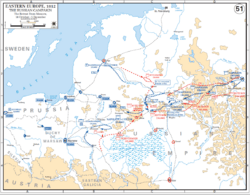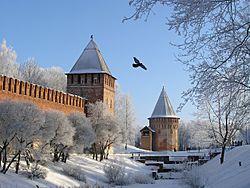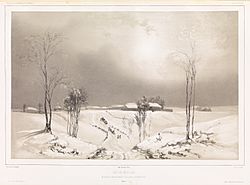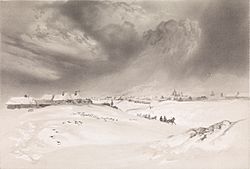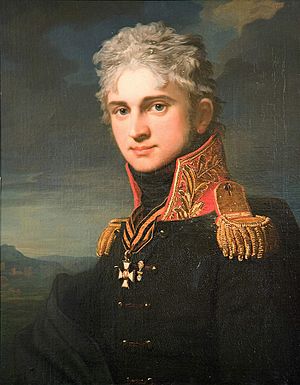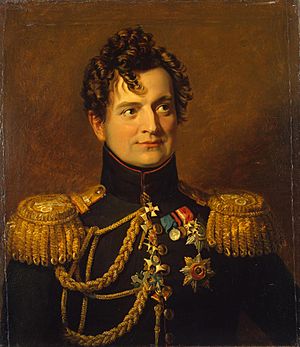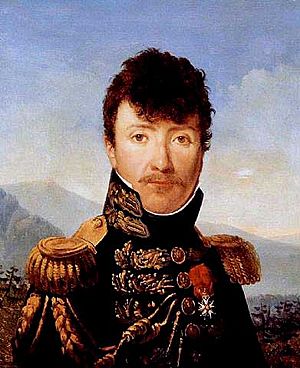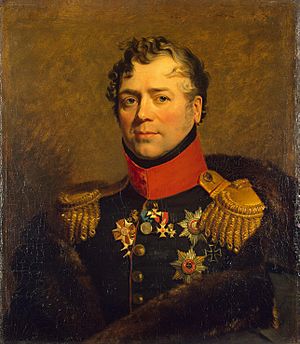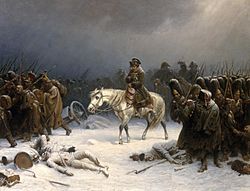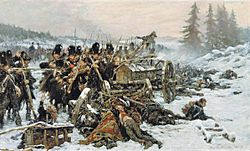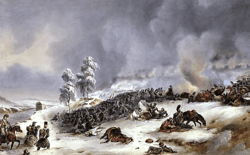Battle of Krasnoi facts for kids
Quick facts for kids Battle of Krasnoi |
|||||||
|---|---|---|---|---|---|---|---|
| Part of the French invasion of Russia | |||||||
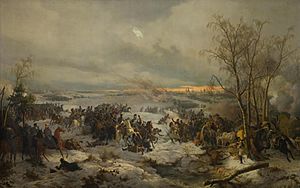 Battle of Krasnoi on 17 November 1812, by Peter von Hess |
|||||||
|
|||||||
| Belligerents | |||||||
| Commanders and leaders | |||||||
|
|
||||||
| Strength | |||||||
| 41,500 combatants 35,000 stragglers |
50,000 to 60,000 regular troops 20,000 Cossack cavalry 500 cannon |
||||||
| Casualties and losses | |||||||
| 5 to 13,000 killed, wounded or drowned soldiers and stragglers 26,500 prisoners (almost all stragglers) and 228 cannon. |
2,000 to 5,000 killed and wounded | ||||||
The Battle of Krasnoi (at Krasny or Krasnoe) unfolded from 15 to 18 November 1812 marking a critical episode in Napoleon's arduous retreat from Moscow. Over the course of six skirmishes the Russian forces under General Kutuzov inflicted significant blows upon the remnants of the Grande Armée, already severely weakened by attrition warfare. These confrontations, though not escalated into full-scale battles, led to substantial losses for the French due to their depleted weapons and horses.
Throughout the four days of combat, Napoleon attempted to rush his troops, stretched out in a 30-mile march, past the parallel-positioned Russian forces along the high road. Despite the Russian army's superiority, Kutuzov hesitated to launch a full offensive, according to Mikhail Pokrovsky fearing the risks associated with facing Napoleon head-on. Instead, he hoped that hunger, cold and decay in discipline would ultimately wear down the French forces. This strategy, however, led him in a nearly perpendicular course, placing him amidst of the separated French corps.
On 17 November a pivotal moment occurred when the French Imperial Guard executed an aggressive feint. This maneuver prompted Kutuzov to delay what could have been a decisive final assault, leading him to seek support from both his left and right flanks. This strategic decision allowed Napoleon to successfully withdraw Davout and his corps but it also led to an immediate retreat before the Russians could capture Krasny or block their escape route. Kutusow opted not to commit his entire force against his adversary but instead chose to pursue the French relentlessly, employing both large and small detachments to continually harass and weaken the French army.
The decision to divide into columns proved catastrophic, resulting in heavy defeats for the corps of Eugene, Davout and Ney throughout the four days of relentless combat. The Russians captured a significant number of prisoners, including several generals and 300 officers, while the Grande Armée was forced to abandon most of its remaining artillery and baggage train.
Overall, the Battle of Krasnoi inflicted devastating losses upon the French forces, amplifying their already continuous losses during their perilous retreat. Despite the valiant efforts of the Imperial Guard, the confrontation left the French military in dire straits and without supply, further weakening their already battered army.
Contents
The forces converge on Krasny
Napoleon retreats from Smolensk
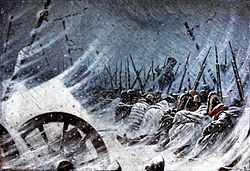
Consisting of 100,000 combat-ready yet undersupplied troops, the Grande Armée, departed Moscow on 18 October, aiming to secure winter quarters via an alternative route to Kaluga. Following the loss at the Battle of Maloyaroslavets Kutuzov compelled Napoleon to shift northward, retracing the same ravaged path he had aimed to avoid. Smolensk, situated approximately 360 km (220 mi) to the west, was the nearest French supply depot. Despite fair weather, the three-week march to Smolensk proved disastrous, subjecting the Grande Armée to challenges like traversing a sparsely populated area with continuous forest, abandoned villages, grappling with demoralization, disciplinary breakdowns, hunger, extensive loss of horses and crucial supplies, as well as persistent harassment from Cossack irregulars and partisans who made it impossible to forage. While sources are not definitive, it's estimated that he arrived with as few as 32,000, perhaps 50,000 men. The situation worsened with the advent of an early and harsh "Russian Winter", commencing on 5/7 November.
By 8/9 November, when the French reached Smolensk, the strategic situation in Russia had turned decisively against Napoleon. Merely 40% (37,000) of the remaining Grande Armée was still combat-ready. Concurrent losses on other fronts further exacerbated their dire circumstances. Encircled by encroaching Russian armies that imperiled their retreat, Napoleon recognized the untenability of his position at Smolensk. Consequently, the new strategic goal became leading the Grande Armée westward into winter quarters, targeting the area of the extensive French supply depot of Minsk.
Having lost contact with Kutuzov over the past two weeks, Napoleon mistakenly assumed that the Russian army had suffered equally due to harsh conditions. Underestimating the potential for a Kutuzov-led offensive, Napoleon made the tactical blunder of resuming his retreat. He dispatched the individual corps of the Grande Armée from Smolensk on four successive days, starting on Friday 13 November with Polish Polish Corps under Zajączek, who replaced the wounded Józef Poniatowski. Next came the Westphalians. Napoleon left on the 14th, preceded by Mortier with the Legion of the Vistula and Michel Claparède who departed with the treasure and baggage wagons, Davout on the 15th, Beauharnais on the 16th, and Ney on the 17th. This resulted in a fragmented column of disconnected corps, spanning 50 km (31 mi), ill-prepared for a significant battle. As the soldiers, including the sick and wounded, improvised unconventional methods to withstand the cold, the scene resembled a disordered carnival procession.
A blizzard struck on 14 November, bringing heavy snowfall of approximately 1.5 meters (5 feet) and a temperature plummet to -21 °R (= -25°C or -14°F). This led to further casualties among men, horses, and the abandonment of artillery. Ostermann-Tolstoy, part of Miloradovich's avant-guard, shelled Napoleon and his guards, but the assault was repelled. While Miloradovich desired to attack, he was not granted permission. Meanwhile, Claparède and the Vistula-legion arrived at Krasny since August occupied by a French battalion. They were expelled by Ozharovsky's flying column.
In the afternoon of 15 November, Napoleon himself arrived at Krasny accompanied by his 14,000-strong Imperial Guard. His plan was to await the arrival of the troops of Eugène, Davout and Ney over the next several days before recommencing the retreat. In the intervening space between and around these French corps, nearly 40,000 disintegrated troops formed mobs of unarmed, disorganized stragglers.
Kutuzov's southern march
During the same period, the main Russian army under Kutuzov followed the French on a parallel southern road. This route passed through Medyn and Yelnya, the latter became a significant center for the partisan movement. Unlike the Grande Armée, the main Russian army approached Krasny in a much less weakened state, but still had to contend with the same, extreme weather conditions. Kutuzov promoted an easy retreat for the French army and initially forbade his generals to cut off their retreat. General Bennigsen, who disagreed, was sent to Riga.
Due to outdated intelligence reports, Kutuzov somehow believed that only one-third of the French army had passed from Smolensk to Krasny with the remainder of Napoleon's forces marching much farther to the north or still at Smolensk. On this basis, Kutuzov accepted a plan proposed by his staff officer, Colonel Toll, to march on Krasny to destroy what was believed to be an isolated French column. Kutuzov apologized for not always knowing what to do due to lack of information and dependence on rumors.
The Russian position at Krasny, located in the Pale of Settlement, began forming on 15 November, when the 3,500-strong flying advance guard of Adam Ozharovsky took possession of the town and destroyed shops and stock before the French arrived. On the same day, the 18,000 troops of Miloradovich established a strong position, across the high road about 4 km (2.5 mi) before Krasny. This movement effectively separated Eugene, Davoust, and Ney from the Emperor. On 16 November Kutuzov's 35,000-strong main force slowly approached from the south, and halted 5km from the main road to Krasny. Another 20,000 Cossack irregulars, operating mostly in small bands, supplemented the main army by harassing the French at all points along the long road to Krasny.
In total, Kutuzov commanded a force of 50,000 to 60,000 regular troops, which included a substantial cavalry unit and around 50/200 cannon, some transported on sledges. Kutuzov's forces were organized into two columns. The larger contingent, under the leadership of General Alexander Tormasov, formed the left flank and maneuvered around Krasny so Napoleon could not withdraw. Meanwhile, the second column, led by Prince Dmitry Golitsyn and Pavel Alexandrovich Stroganov, held the army's center and launched an attack on Krasny. Miloradovich's position anchored the Russian right flank, controlling a vital road to Krasny. This road required the French army to cross a stream within a gully. Despite Miloradovich's pivotal role, he left his strategic position to aid Golitsyn against the Young Guard. Consequently, Davout managed to successfully cross the Losvinka, albeit at the cost of his rearguard's sacrifice.
15 November: the rout of Ozharovsky
Outside Smolensk, leaving the floodplain of the Dniepr, there is a steep slope passing into a long descent, slightly undulating until Krasny. Near Merlino, around noon, the Imperial Guard, led personally by Napoleon, marched past Miloradovich's troops, who were positioned left of the road, backed by a forest. Impressed by the order and composure of the elite guardsmen, Miloradovich had orders from Kutuzov not to attack them, and settled instead for bombarding the French at extreme range. The Russian cannon fire inflicted little damage on the large corps of Guards which continued moving toward Krasny.
As Napoleon and the Imperial Old Guard approached, it was fired upon by Ozharovsky and Russian infantry and artillery. A surprised army did not expect attacks from the front. Not long after, the Imperial Guard was harassed by the Cossacks of Vasily Orlov-Denisov, who captured 1,300 soldiers, 400 carts and 1,000 horses.
Before dusk, Napoleon and his Guard entered Krasny. He planned to remain at least for a day so that Eugene and Davout could catch up with him. However, part of this small town was set on fire after the French Guards took shelter in the monastery, barns and houses. The streets were filled with soldiers; the Young Guard camped east, outside the town. Napoleon decided to force the withdrawal of Ozharovsky's 3,500 Cossacks from the Losvinka.
Shortly after midnight, it was two o'clock when the movement began on Ozharovsky's force who were pushed back south of Krasny. Recognizing that Ozharovsky's position was dangerously isolated from Kutuzov's main army, Napoleon dispatched the Young Guard under General Michel Claparede on a surprise attack against the Russian encampment, which was not protected by pickets. The operation against their center was first entrusted to General Jean Rapp, but at the last moment, Rapp was replaced with General François Roguet then divided the Guardsmen into three columns. They began a silent advance on Ozharovsky's camp, although the snow was up to their knees. (The Old Guard stayed at Krasny and did not fight that day.) The Young Guard (under Delaborde) launched a counterattack in the middle of the night and drove Ozharovski's detachment from the brooklet. Golitzin therefore decided to await Miloradovich's co-operation before pressing his advance. In the ensuing combat, the Russians were taken by surprise during their sleep and, despite their fierce resistance, were routed. As many as half of Ozharovsky's troops were killed with bayonets or captured, and the remainder threw their weapons in a pond and fled. Lacking cavalry, Roguet was unable to pursue Ozharovsky's remaining troops.
16 November: the defeat of Eugène
Miloradovich attacks
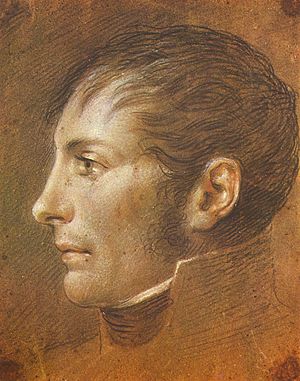
Near Krasny Mikhail Miloradovich put up a barrier across the road, by a detachment of infantry, light cavalry and half of the Russian artillery. On a beautiful plateau according to Roguet.
On 16 November, the situation took a turn for the worse for the French. Kutuzov's forces closed in on the main road but refrained from launching an attack. In contrast, Miloradovich's troops dealt a severe blow to Prince Eugène de Beauharnais who refused to surrender. In this skirmish, his Italian Corps lost one-third of its original strength, along with its baggage train and artillery at the Losvinka. Reduced to only 3,500 combatants, without any cannons or supplies, Eugène was left with no choice but to wait until nightfall and then find an alternate route around the Russian forces. Eugène fooled the Russian general by attacking his army on the left flank but managed to escape with part of his soldiers to the right. This escape was partly due to Kutuzov's decision to restrain Miloradovich and prevent the skirmish from escalating into a full-scale battle, much to the surprise of both Russian and French forces.
Kutuzov at Zhuli
Earlier that day, Kutuzov's main army finally arrived within 26 km (16 mi) of Krasny, taking up positions around the hamlets of Novoselye and Zhuli. Despite being in a favorable position to attack the French, Kutuzov hesitated. He opted for a day of rest for his troops, delaying any decisive action.
In the evening, Kutuzov faced pressure from the disagreeing junior generals, especially Wilson, urging him to launch a decisive attack against Napoleon. However, he remained cautious and only planned for an offensive. He forbade his commanders from executing it until daylight. The Russian battle plan involved a three-pronged attack on Krasny: Miloradovich was to hold his strategic position on the hill, blocking the advance of Davout and Ney. The main army would split into two groups: Golitsyn would lead 15,000 troops and halt on the right bank of the Losvinka, in full sight of Krasny, while Tormasov commanded 20,000 troops tasked with encircling Krasny and cutting off the French retreat route to Orsha. Ozharovsky's flying column, weakened after their defeat by the Young Guard, would operate independently west of Krasny. The remnants of Eugène's Westphalian Corps were incapable of taking any part in the action, when they arrived late in the evening. Napoleon ordered it to defile on the road to Orsha as Krasny was full with soldiers.
However, at some point, Kutuzov received information from prisoners (quartermaster Puybusque and his son) that Napoleon intended to remain in Krasny and wait for Ney and not withdraw as Kutuzov had anticipated upon the arrival of Davout. This revelation caused Kutuzov to reconsider the planned offensive after Ozharovsky's defeat, as reported by Nafziger and Gourgaud.
17 November: Napoleon's bold maneuver
Peril for Davout
At 3:00 a.m., Davout's I Corps began their march towards Krasny in response to troubling reports of Eugene's defeat the previous day. Originally, Davout had planned to wait for Ney's III Corps, which was still at Smolensk, to catch up. However, sensing a relatively clear path, he approached the Losvinka around nine in the morning.
Unfortunately, Miloradovich, with Kutuzov's permission, initiated a massive artillery barrage on Davout's corps. This unexpected attack caused panic among the French troops, leading to a hasty retreat from the road and leaving the rear guard on the brink of destruction. Davout's corps suffered heavy casualties, with only 4,000 men remaining.
An intriguing, though poorly documented incident occurred near the Losvinka when the rear end of the I Corps baggage train, including Davout's jammed carriages, fell into the hands of the Cossacks. Among the items captured by the Russians were Davout's war chest, numerous maps depicting the Middle East, Central Asia, and India, his Marshal baton and an item of significance in the peace negotiations with Tsar Alexander, Some sources mention a substantial sum of money as part of the haul. The exact location of this incident, whether it occurred east of Krasny in the morning or west of Krasny in the afternoon, remains unclear.
Napoleon orders the Guard's advance
Napoleon, realizing the grave danger confronting the Grande Armée, made a bold decision. Waiting for Ney in Krasny was no longer a viable option, as any determined attack by Kutuzov could spell doom for the entire army. Additionally, the starving French troops needed to reach their closest supply source, 40 km (25 mi) west at Orsha, before the Russians could capture the town.
In this critical moment, Napoleon's "sense of initiative" returned, marking the first time in weeks. As Caulaincourt's described it: "This turn of events, which upset all the Emperor's calculations... would have overwhelmed any other general. But the Emperor was stronger than adversity, and became the more stubborn as danger seemed more imminent."
Before daylight, Napoleon readied his Imperial Guard for an aggressive feint against Golitsyn, hoping that this unexpected maneuver would discourage the Russians from attacking Davout. The Guardsmen formed attack columns, and the remaining artillery of the Grande Armée was assembled for combat. Napoleon's plan was to hold off the Russians long enough to gather the troops of Davout and Ney, resuming the retreat before Kutuzov could attack or outflank him on the way to Orsha.
The Imperial Guard gives a demonstration in force
At 2:00 a.m., 11,000 Imperial Guards (4 regiments) marched out of Krasny to secure the terrain immediately east and southeast of the town. For the first time, Napoleon deployed the Imperial Old Guard, consisting of 6,000 above-average height men, to confront the Cossacks blocking the road beyond Krasny near the Losvinka. "I have played the Emperor long enough! It is time to play general!"
The Guardsmen faced Russian infantry columns to the south and east, backed by massive, formidable artillery batteries (commanded by Golitsyn and Stroganov). However, the Young Guards were at a disadvantage due to their lack of sufficient artillery. As Segur eloquently described it: "Russian battalions and batteries barred the horizon on all three sides—in front, on our right, and behind us"
Kutuzov's reaction to the Imperial Guard's bold movement was decisive and controversial; he promptly cancelled the planned offensive, despite of the Russians' overwhelming strength.
In the morning Milodarovich moved south to support Golitsyn against the Young Guards. When Miloradovich left his hilltop position to assist in the fight, he left a detachment of Cossacks. Davout managed to fight his way through and enter Krasny. The Guard's audacious feint allowed Napoleon to rescue Davout's corps from potential destruction.
Action at the Losvinka brook
On this particular day, the morning and early afternoon witnessed limited close-quarters combat around Uvarovo in the center. The Young Guard initiated an attack to provide cover for Davout's crossing of the Losvinka more north.
Uvarovo, a half-hour's walking from Krasny, was held by two battalions of Golitsyn's infantry, forming a frail forward outpost ahead of the main Russian army. However, the Russians were eventually forced out of Uvarovo. In response, Golitsyn launched a devastating artillery barrage, causing heavy casualties on the Young Guardsmen.
Kutuzov ordered Miloradovich to shift his position in order to link up with Golitsyn's lines, concentrating as much strength as possible behind Golitsyn's forces. Unfortunately, this realignment prevented Miloradovich from completing the destruction of Davout's troops.
Meanwhile, Davout's troops continued their westward movement, constantly harassed by Cossacks. Russian artillery relentlessly pounded Davout's corps with grapeshot, resulting in devastating casualties for the I Corps. Although Davout's personal baggage train suffered heavy losses, a considerable number of his infantrymen were saved and rallied in Krasny. As soon as Davout and Mortier had established communication, Napoleon initiated his retreat upon Lyady with the Old Guard and the cavalry, except for the (Dutch) Grenadiers and Lancers, who were left to support Mortier and engage the Russians.
Davout's rearguard (chasseurs of the Dutch 33rd Regiment) faced attacks from Cossacks, cuirassiers and infantry, becoming encircled and running out of ammunition. The regiment formed defensive squares and successfully repelled the attack. However, during the third Russian attack, they became trapped and soon the entire regiment was either killed in combat or captured, with only 75 men surviving.


